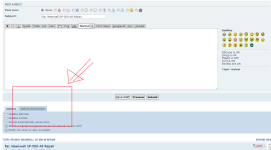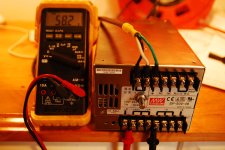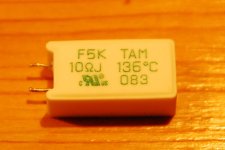Degull
100 W
Hi everyone. I bought a supposedly working Meanwell SP-500-48 from ebay very cheap and got taught the age old lesson. You get what you pay for. The power supply showed up dead and it's not worth the shipping to send it back. Thankfully the power supply does not look like it has been previously opened or tampered with. There was no output voltage and the little green LED was not lighting up.
Just to make it easier to follow, there are two boards inside the power supply. I'll refer to the input board where the AC voltage is applied and the output board where the DC voltage is used for output.
http://flic.kr/p/bvqcxK
I started poking around with a DMM and appears that input board has a thermal resistor that has gone open circuit. Here is a pic of the offending part.
http://flic.kr/p/bvqcAe
It is a 10 ohm temperature resistor. I removed the temperature resistor and jumpered it to see what would happen. As soon as I applied power the 10 amp fuse on the input board blew. I replaced the fuse and removed all the connections between the output board and the input board. With power applied to just the input board I can measure 374 volts DC on the connector labeled HV. The 10 amp fuse is fine when the output is not connected to the input board and the fuse is blowing when connected to the output board. I am assuming the problem lies in the output board.
Any suggestions would be appreciated!
Just to make it easier to follow, there are two boards inside the power supply. I'll refer to the input board where the AC voltage is applied and the output board where the DC voltage is used for output.
http://flic.kr/p/bvqcxK
I started poking around with a DMM and appears that input board has a thermal resistor that has gone open circuit. Here is a pic of the offending part.
http://flic.kr/p/bvqcAe
It is a 10 ohm temperature resistor. I removed the temperature resistor and jumpered it to see what would happen. As soon as I applied power the 10 amp fuse on the input board blew. I replaced the fuse and removed all the connections between the output board and the input board. With power applied to just the input board I can measure 374 volts DC on the connector labeled HV. The 10 amp fuse is fine when the output is not connected to the input board and the fuse is blowing when connected to the output board. I am assuming the problem lies in the output board.
Any suggestions would be appreciated!





